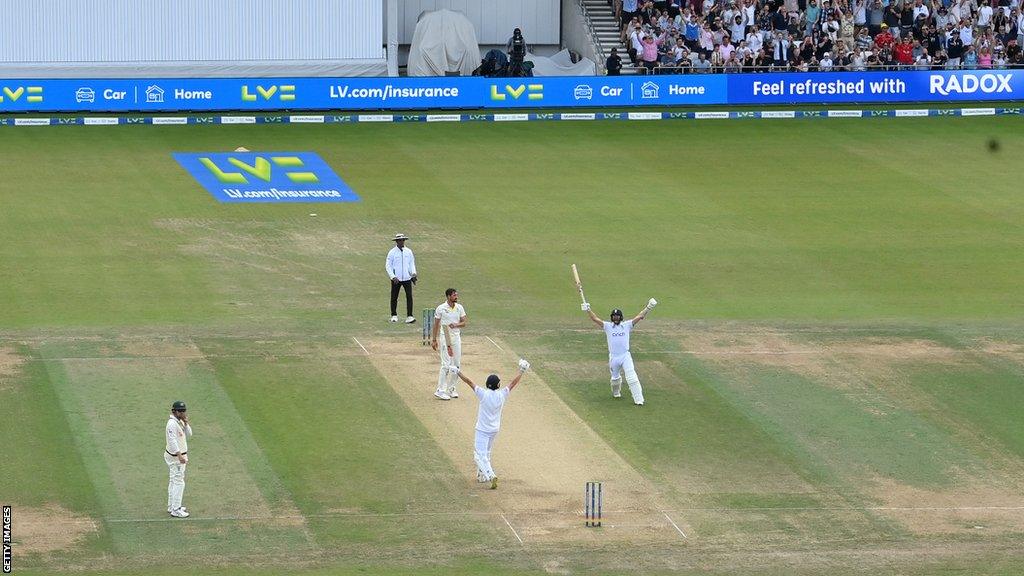Andy Zaltzman: Why this year's men's Ashes is most closely fought in history... so far!
- Published

Mark Wood was England's youngest wicket-taker at Headingley at the age of 33
Men's Ashes: England v Australia |
|---|
Venue: Emirates Old Trafford Date: Wednesday, 19 July Time: 11:00 BST |
Coverage: Live text commentary and in-play video clips on the BBC Sport website & app, plus BBC Test Match Special on BBC Sounds and BBC Radio 5 Sports Extra. Daily Today at the Test highlights on BBC Two and BBC iPlayer from 19:00 BST. |
In the much-hyped age of sporting overhype, it can be difficult for contests to live up to their hyper-hyped expectations.
This summer's two Ashes series have managed to do so, generating constantly fluctuating and varied drama, both within matches and across the series, replete with individual and collective subplots, and the cocktail of brilliance, flaws and struggle that forms the best of sport.
A cricket series is rare in the sporting universe in that it sets the same opponents against each other over a prolonged period and sequence of matches, a quality that makes these Ashes series the much-see TV box set epic of the summer.
The three men's Tests could each have been won by either side. The difference between the teams after first innings has been less than 100 runs in all three matches - seven runs in Birmingham, 91 at Lord's, 26 at Headingley.
In the last Ashes in Australia, only one of the five matches (Sydney) had a first-innings gap below 100. There were three such matches in 2019, but only five in 30 Tests in the six series before that (2009 to 2017-18).
There had only been six Ashes Tests with a first-innings gap below 30 runs in the last 20 Ashes series combined, since 1985. The last time we had two such games in a series in England (excluding rain-affected matches where first innings were incomplete) was in 1909.
In all 343 men's Ashes Tests played before this series, there had been only 25 matches won by margins of under 50 runs or by three or fewer wickets, equating to approximately one every three five-match series (none of the 25 happened in the 1960s or 1970s).

England got over the line in another tight game at Headingley in the third Test
We have now had three in succession, after the most dramatic sequence of Ashes Tests since the second, third and fourth Tests of the 2005 series - wins for England by two runs at Edgbaston and three wickets at Trent Bridge, either side of Australia clinging on for a draw with nine wickets down at Old Trafford.
As cricket fans, we have been treated to the type of soul-enveloping narrative that only Test series can create, enhanced by the striking difference in approach of the two sides, which is revealed perhaps most strikingly in the percentage of deliveries from which each team's batters has scored runs.
In the first three Tests, England have scored off 38.4% of the balls they have faced (currently the third highest such figure in a series of three or more Tests), Australia just 24.8%.
The 13.6% gap is currently the fourth biggest recorded - England's even-more-Bazballistic performance in Pakistan last December also tops this table (43.7% to 25.4%) - and the biggest ever in an Ashes series, by either side.
There is little difference between the teams in the frequency with which they hit boundaries - England one every 12.8 balls, Australia one every 13.9 - but England have been more proactive in trying to keep their score advancing, and Australia more cautious with the bat and more defensive in their field-placing.
Wary of England's scoring rate and the way they have batted in the Stokesian era, Australia are posting more boundary fielders, attempting to reduce the number of fours, but facilitating lower-risk accumulation of singles and twos.
England under Stokes, other than when employing their bouncer tactics, tend to retain more close-catching and single-preventing fielders, at the risk of allowing more boundaries to be hit.
In this series, both sides could argue their approach has been largely vindicated.
Australia's more restrained strategy helped them into a 2-0 lead. They have taken wickets steadily in all three Tests, preying on England's addiction to risk.
But for the incandescent brilliance of Mark Wood in their first innings at Headingley, and the baffling carelessness of Labuschagne and Smith in the second, they would probably be 3-0 up.
England could have won all three Tests. Their capacity for hammering boundaries, which has discombobulated New Zealand, India and Pakistan in the past year, made Australia take a strategic decision to be, mostly, passive and containing in the field.
England's narrow defeats at Edgbaston and Lord's swung on errant fielding and a few critical moments. In their successful run-chase at Leeds, from the 22nd over until winning in the 50th, they did not allow more than four dot balls in a row, so even while wickets were falling regularly, they were moving closer to the victory target at a good rate.
Old Trafford promises to be another fascinating tussle. Wood's phenomenal speed has given England a new weapon (all the best long-form dramas introduce a major character some way into the story - and killing off Nathan Lyon so early in the series was positively Game-of-Thronesian).
Both sides have shown weaknesses that can be exploited, and strengths that could prove decisive. Cricket lovers around the world will be eagerly ready to binge-watch the next instalment.
Here's 10 more statistics for you to drop into conversation during any job interviews, dates, trade negotiations, trials or parliamentary hearings you may have to attend in the next couple of days:
STAT 1: Stuart Broad, now two wickets away from becoming the fifth bowler to take 600 in Tests, has taken at least five wickets in each of the last seven Tests he has played - an unprecedented achievement by an England bowler. Prior to Broad's current sequence, only post-war great Alec Bedser had taken five or more in six consecutive Tests for England.
STAT 2: All 20 Australian wickets at Headingley were taken by England bowlers aged 33 and over - the first time in Test history that a team has lost all 20 wickets to bowlers aged at least 33. In all, 36 of the 37 wickets in the Test were taken by bowlers aged 30-plus (Todd Murphy's dismissal of Ben Stokes was the exception).
This is the joint-highest match tally for 30-plus bowlers in Test history, alongside the Adelaide Test of 1928-29, another classic Ashes Test with four close innings - England made 334, Australia replied with 369, England scored 383 in their second innings, before bowling Australia out for 336 to win by 12 runs.
STAT 3: Headingley was just the third Ashes Test in which all four innings were in the 200s, although the 39-run difference between the highest and lowest innings was considerably more than the other two, both of which were Boxing Day Tests at the MCG. In 1974-75, the game finished drawn with Australia 238-8, eight runs short of victory after England made 242 and 244, either side of Australia's first innings 241.
The dramatic 1982-83 MCG Test resulted in a three-run England win - their 284 and 294 emerging victorious over Australia's 287 and 288.
STAT 4: After three Tests, there have been no scores over 420 or under 220, the first time this has been the case after three matches of an Ashes series.
STAT 5: Chris Woakes took England across the line with 32 not out. It was the second time he has made a crucial fourth-innings contribution to an England victory, following his superb 84 not out, batting at seven, against Pakistan at Old Trafford in 2020.
Only one other player in Test history has two scores of 30 or more, batting in the lower order (number seven downwards, for the purposes of this stat), in victorious fourth-innings chases - England's Dominic Cork (39 not out v New Zealand, Christchurch, 1996-97; and 33 not out v West Indies, Lord's, 2000).
STAT 6: England's 254-7 in 50 overs was the seventh successful fourth-innings chase of 250 or more scored at more than 4.5 runs per over. Three of the previous six were made by England last summer, in consecutive Tests (against New Zealand at Trent Bridge and Headingley, and against India at Edgbaston).
STAT 7: It was only the third time since 1955 that England have won a Test without at least one partnership reaching 60.
STAT 8: Australia's only productive batters at Leeds were Travis Head and Mitchell Marsh, batting at five and six. Australia's one to four managed just 139 runs in the match (their second worst top-four match total in a Test in England since 1981, counting matches in which they have batted in both innings).
Their numbers seven to 11 scored just 56, their third worst such total in a Test in England since 1961. The combined total of 195 by the top four and bottom five was Australia's second worst in a Test against England, in either hemisphere, since 1912. Only their Broad-inspired 2015 Trent Bridge demolition was worse (184 in total).
STAT 9: Leeds was the second Ashes Test since 1997 not to include a fifty by a top-four player on either side.
STAT 10: Pat Cummins took 7-168 in 33 overs in the match at Leeds, at 5.1 per over. It was the first time in his 53-Test career that he has conceded more than 4.2 per over in a match.